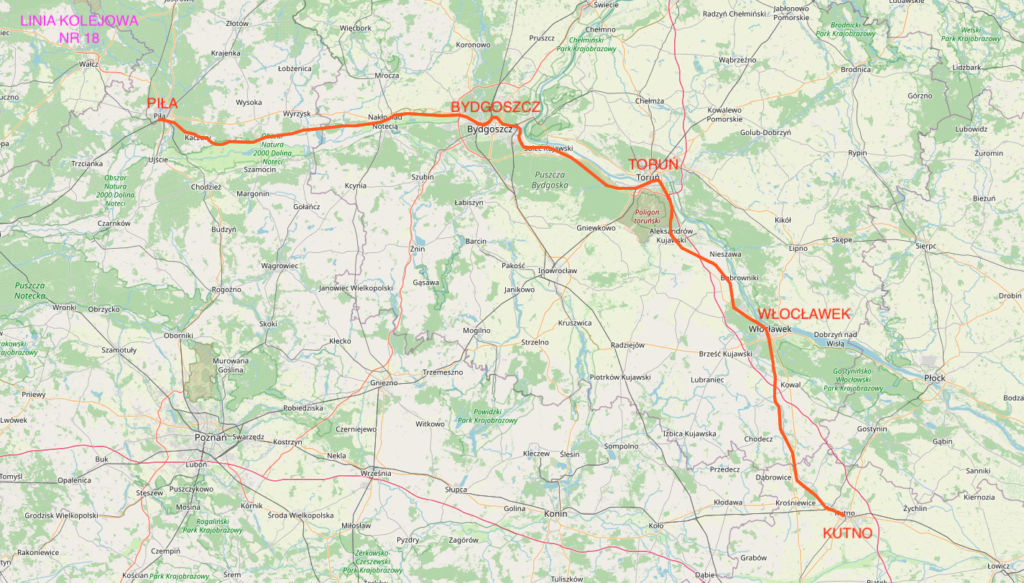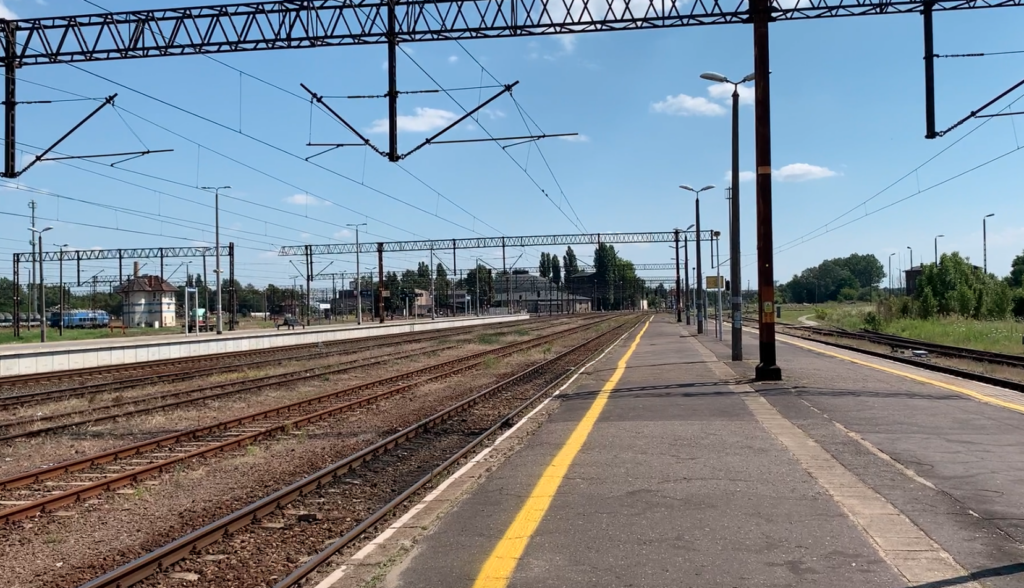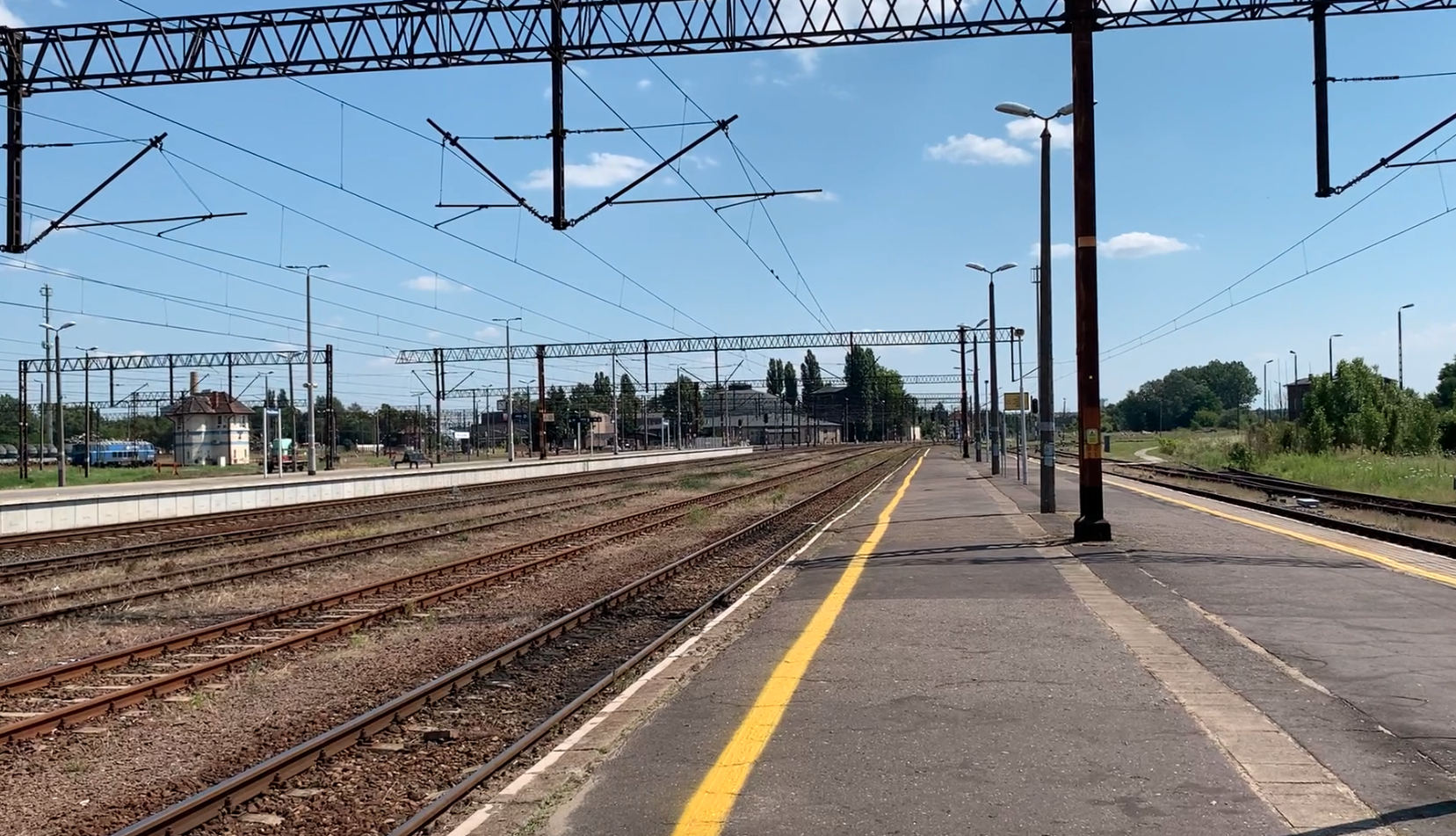Piła 18-08-2024
Railway line No. 18 Kutno – Piła Główna.
Railway line No. 18 Kutno – Piła Główna, is a first-class double-track line, 247.418 km long. The line is electrified. The SHP system operates on the line. The line is adapted to speeds from 40 km/h to 140 km/h, and its design speed is 160 km/h. On the Kaliska Kujawskie – Czerniewice section, the speed of passenger trains is up to 160 km/h. On line No. 18 there are 48 different operating points, including 21 railway stations (of which 2 are technical stations), 25 stops (of which 3 are also loading bays), one track siding and one branch post. The line runs through the area of the Łódź province, the Kuyavian-Pomeranian province and the Wielkopolska province. On the map of Poland, the line runs in a distinct arc.


Railway line No. 18 starts at Kutno station, at junctions No. 71 (odd track) and No. 74 (even track). The line runs north-west through Nowe Ostrowy, Rutkowice and Kaliska. Later it runs north through Czerniewice to Włocławek, and then again north-west in the close vicinity of the Vistula River through Lubanie, Aleksandrów Kujawski to Toruń. The line runs through the southern part of Toruń Główny station. The Kutno – Piła Główna railway line heads west and passes through Solec Kujawski to the eastern part of Bydgoszcz. From there it runs parallel to the Brda River. It runs through Bydgoszcz Wschód and Bydgoszcz Główna stations. The line heads west, in the vicinity of the Bydgoszcz Canal, and then the Noteć River. It passes through Nakło nad Notecią, where it intersects with the Oleśnica – Chojnice railway line. In the further section the line passes Osiek nad Notecią, Białośliwie, Kaczory and reaches Piła. The line ends at junctions No. 544 and No. 545, at the Piła Główna station.
The Piła Główna – Nakło nad Notecią – Bydgoszcz Główna railway route is one of the oldest in Poland. It was established in 1851, as part of the Prussian Eastern Railway – Ostbahn, the aim of which was to connect the Prussian and Muscovite brothers. The cities of Toruń and Włocławek obtained a railway connection in 1861, as a result of the construction of the Warsaw-Bydgoszcz Railway. Until the end of the 20th century, all trains from Western Europe to Warsaw ran via Poznań – Gniezno – Inowrocław – Toruń – Kutno. On the other hand, the Vienna Railway and the Kutno – Bydgoszcz – Gdańsk section were important export routes for Polish hard coal.
On December 4, 1861, the Kutno–Aleksandrów Kujawski section was opened. On December 5, 1862, the Aleksandrów Kujawski–Toruń Główny section was opened. On October 24, 1861, the Toruń Główny section was opened – the then border between the occupying powers. On July 26, 1943, the then border – Bydgoszcz Główna section was opened. On July 27, 1851, the Bydgoszcz Główna–Piła Główna section was opened.
Opening of the second track.
In 1953, the Kutno – Aleksandrów Kujawski section. In 1916, the Aleksandrów Kujawski – Toruń Główny section. The Toruń – Piła section was double-track from the very beginning.
Electrification of LK No. 18.
On December 21, 1985, the Kutno – Aleksandrów Kujawski section was electrified. On May 31, 1985, electrification on the Aleksandrów Kujawski – Toruń Główny section. On July 20, 1984, Toruń Główny – Bydgoszcz Wschód. On May 10, 1967, Bydgoszcz Wschód – Bydgoszcz Główna. On December 23, 1989, Bydgoszcz Główna – Piła Główna.
The exact route of LK No. 18.
Kutno 0.000 km. LK No. 13 passes a freight station. Kutno Zachód 3.000 km. The line crosses the DW No. 581 rail-road junction. Ostrowy 13.658 km. The line runs among fields. Rutkowice 21.134 km. The line crosses DK No. 91 at a rail-road crossing. Kaliska Kujawskie 27.287 km. Wiktorowo 33.290 km. The line passes the Lubieńka River on a bridge. Czerniewice and the rail-road junction with DW No. 269. Czerniewice 38.555 km. The A1 Motorway (E75, Amber Motorway) runs above the tracks. Gołaszewo Kujawskie 42.662 km. Here is a rail-road intersection with DW No. 265. The line crosses the Rakułówka River by a bridge. Warząchewka 47.056 km. The line runs through forests. The line runs above DK No. 62 at the top. The important Wronia Street in Włocławek runs above. Before the station, Kaliska Street runs below. Włocławek 54.808 km. After the station, Kapitulna Street runs below. The line passes the Zgłowiączka River. Then there are three rail-road intersections. Włocławek Zazamcze passenger stop 57.048 km. The station had a footbridge over the tracks, and after renovation there is a pedestrian tunnel. Włocławek Zazamcze freight station 59.956 km. The line passes DW No. 252 at a rail-road intersection. Brzezie 62, 943 km. Above the line runs DK No. 91; Toruńska Street. Lubanie 69.223 km. There are agricultural areas here. Nieszawa Waganiec 77.189 km. The line runs under DK No. 91 and under the A1 Motorway (E75, Amber Motorway). Turzno Kujawskie 84.160 km. The line crosses the rail-road intersection DW No. 266. Aleksandrów Kujawski 91.702 km. The line passes the Tążyna River on a brick arch bridge. Otłoczyn 95.947 km. Nearby, the largest railway disaster in Poland took place on August 19, 1980. 67 people died. The line again runs over the A1 Motorway (E75, Amber Motorway) on a railway viaduct. And again, the line runs over the A1 Motorway (E75, Amber Motorway) on a railway viaduct. Brzoza Toruńska 101.493 km. Toruń Czerniewice 103.249 km. The line runs twice under DK No. 91. The line passes DW No. 585 at a rail-road intersection. Toruń Główny 109.058 km.
Toruń is a large railway junction. The line runs over DK No. 15 and there is a goods station. Toruń Kluczyki 111.741 km and PolRegio Locomotive Depot. The line runs under the DK No. 10 viaduct. Cierpice 119.304 km. Cierpice Kąkol 120.890 km, passenger stop. Then the line runs through forests. Przyłubie 131.386 km, passenger stop. The line runs under the DK No. 10 viaduct. Solec Kujawski 138.699 km. DW No. 249 runs underneath. Bydgoszcz Łęgnowo 148.699 km. Portowo-Kolejowy Bridge on the Brda River. The track runs under DK No. 80. Bydgoszcz Wschód 152.300 km. A viaduct with tram tracks runs over the station. Bydgoszcz East Towarowa 153,000 km. There is a large locomotive shed on the north side. Over the line runs the DW No. 239 viaduct. Bydgoszcz Bielawy 154.395 km. Over the tracks there is a footbridge for pedestrians. Bydgoszcz Leśna 156.343 km. Over the line there is a viaduct named after Józefa Święcicki in the course of Gdańska Street. Then over the line there is the Independence Viaduct in the course of DK No. 80, Witolda Pilecki Street. Next to it is the PESA company. Bydgoszcz Główna 160.058 km. There is a large railway junction in Bydgoszcz. Further on there are railway bridges over the Brda River and over Żeglarska and Nadrzeczna streets. The bridges are historic, brick, arched. Czyżkówko 162.578 km. The line runs over DW No. 238. The line runs over the Bydgoszcz Canal. Bydgoszcz West 163.068 km. Prądy 164.762 km. Bydgoszcz Osowa Góra 165.979 km. The line runs under DK No. S5. Pawłówek 169.863 km, passenger stop. Zielonczyn 173.095 km. A railway disaster occurred on 3rd June 1972, on the Ślesin – Zielonczyn section. As a result, 12 people died and 26 were injured. The cause of the disaster was the derailment of a train on the Kołobrzeg – Warszawa Główna route. Ślesin 180.203 km. Nakło nad Notecią 186.887 km. A viaduct DW No. 241 runs above the station. Anieliny 195.140 km. Samostrzel 198.674 km. Jadwiżyn 202.833 km. Wyrzysk Osiek 208.183 km, in the town of Osiek nad Notecią. Krostkowo 213.983 km. Białośliwie 219.898 km. Miasteczko Krajeńskie 226.963 km, passenger stop. Kaczory 236.800 km. The line runs on DK No. 11. Piła Fabryczna 245.000 km, passenger stop. On the south side there was the Customs Station. Further on there are railway bridges over the Gwda river. Piła Główna 247.181 km.
Modernization of LK No. 18.
From July 2012 to March 2014, the largest modernization of the Bydgoszcz – Toruń line section was underway. 92 km of tracks, 18 rail-road crossings and many bridges and culverts were renovated. 54 new turnouts were installed at the following stations: Toruń Główny, Cierpice, Solec Kujawski, Bydgoszcz Łęgnowo, Bydgoszcz Wschód and Bydgoszcz Leśna. Railway traffic control devices and power supply systems were also replaced. The speed of trains was increased to 120 km/h. The total amount of the renovation was PLN 226 million.
On June 12, 2016, a new passenger stop Cierpice Kąkol was opened. Since June 2016, the renovation of the Włocławek – Aleksandrów Kujawski section has been underway. 14 km of tracks and many turnouts were replaced. The platforms in Lubań, Turzno Kujawski and Nieszawa Waganiec were rebuilt. As a result of the renovation, the speed of trains was increased to 140 km/h.
Since June 2017, the renovation on the Ostrowy – Otłoczyn section has been underway. In 2024, the fourth stage of the modernization of the Kutno – Toruń route was completed. The fourth stage of the modernization of railway line no. 18 on the Kutno – Toruń Główny section is underway. The investment was carried out from national funds, without EU funds. The value of the project is almost PLN 43 million. The contractor was the consortium of Polski Holding Budowlany Infrastruktura – Górtor – PIB Kopacki. The works included the reconstruction of 14 km of tracks. Some rail-road crossings received new barriers, traffic lights and monitoring.
On some sections, trains run at higher speeds. On the Włocławek – Brzezie – Aleksandrów Kujawski section, passenger and freight trains run at speeds of up to 140 km/h and 100 km/h, respectively. Before the works, the maximum speed was 120 km/h and 80 km/h. On the Kaliska Kujawskie – Czerniewice section, the speed of passenger trains increased to 160 km/h. In addition, the traffic control system in Toruń was rebuilt.
In the period 2016–2020, the previous three stages of the route modernization were completed, and the value of the investment reached PLN 200 million. At that time, over 50 km of tracks and the traction network were replaced. The reconstruction also included 27 engineering structures and 21 rail-road crossings.
Written by Karol Placha Hetman

Leave a Reply
You must be logged in to post a comment.